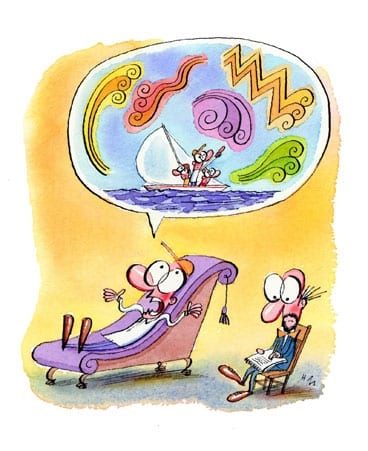
Shifty Characters
ROB: The crew gave me a collective clip around the ear and told me to talk to you about persistent shifts.
Doc: I’m betting you had a rough time on the water today.
ROB: You could say that! We were looking starry after the first beat. Went around the top in third and pulled one back on the run.
Doc: … and …
ROB: Well, we went left up the next beat, the breeze went right, and our place went out the back door.
Doc: … yes?
ROB: Well, we’d worked out that the left was favored before the start—and it worked on the first beat. So we did it again on the second—you know, persistent shift and favored side and all that. How did those other blokes work it out that the breeze would go the other way?
Doc: What sort of persistent shift was it?
ROB: You mean that “continuing” or “completed” stuff? I don’t know! I just figured that coming off the land it would bend left as we got closer to the shore—you know, Coriolis effect and all that stuff.
Doc: Hmm … Did you know there are three kinds of persistent shift—and you sail them quite differently?
ROB: This should be amusing. OK smart guy. Let me have it.
Doc: The first is the fixed persistent shift. That’s the one that usually occurs because of geography or some other fixed influence—particularly where the wind is being channeled or bent. It is as regular as a metronome. You always hit the same side (the way you would with a fixed current benefit). That’s how you treated the upwind of this race you were talking about. It’s a “work-out-which-side-is-favored-and-get-there-fast” sort of approach.
ROB: You are trying to tell me it wasn’t fixed then?
Doc: Was the shift there the second time you tried?
ROB: Point taken.
Doc: So the second type is the one-off persistent shift. This is when a new breeze is coming on the scene (often showing up as the old breeze dying). This one is most often signaled by some weather signals—be they cloud or temperature change, an out-of-range shift, or the breeze substantially strengthening or softening. If your eyes are open, you notice something weird is going on.
ROB: But you still do the same thing, don’t you? You work out which side and go for it.
Doc: Well, yes that is right, except it only works once. The shift goes through, or the new breeze comes in, and then there are new conditions and new rules. The same side might not work next time.
ROB: Aha! That’s what we had then, one of them so-called “one-off” babies!
Doc: Well, no. It doesn’t sound like it actually. Was there a permanent change in the wind conditions?
ROB: Well, no actually. If I didn’t know better, I would have said the breeze actually flicked back and forth all day, just like an oscillating breeze.
Doc: Yes. That would be it.
ROB: But it wasn’t oscillating. It was persistent. It didn’t come back until after the end of the beat. By definition, that is persistent, isn’t it?
Doc: Persistent and oscillating actually.
ROB: Now you’re getting me confused.
Doc: No, really. The third kind of persistent shift is the too-long phase oscillation. You often get those off the low, flat land, particularly on a cold and grey day like today, when there’s not much heating going on. What it means is the breeze is flicking back and forth over quite a long period, which effectively means persistent shifts each beat, but it can favor one side or the other. Strictly speaking, it’s an oscillating breeze, but because it has such long phases, one side or the other usually pays, and so it looks like your regular garden-variety “hit-one-side” persistent shift.
ROB: So you still hit the sides?
Doc: Yes, but you have to work out very early on what long-term phase the breeze is in—left or right—and head for the corner where you expect the next major shift. “Too-long phase oscillations” are hard to pick out because there are usually small short-phase oscillations hiding the bigger pattern. A good clue is if you start getting confused about what the mean wind direction is, then you should start looking for a bigger, longer-phase pattern.
ROB: So you really need to keep track of your compass numbers.
Doc: That’s the key. Not just the minute-to-minute stuff, but the patterns over half an hour or more. When you come around the bottom mark, you’re not focused on heading out to the same side as last time. You’re looking to see if you are in the long-term lifting or knocking phase, and get on the lifted tack smartly.
ROB: Cool! Now I can go and show up that crew of mine. They think they’re so smart.
Doc: Actually, I had the same talk with them two weeks ago.
ROB: Oh … Damn … That was why they got so stroppy when I said, “We’re going right. It worked last time.”
Doc: Sounds like the next round’s on you, skipper.









